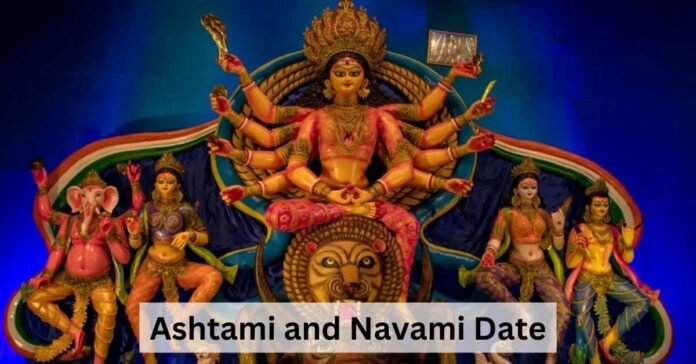
Durga Puja, one of India’s grandest and most cherished festivals, celebrates the triumph of good over evil, symbolized by Goddess Durga’s victory over the demon Mahishasura. While this vibrant festival spans several days, Maha Ashtami and Maha Navami stand out as two of the most significant days, celebrated with great enthusiasm, rituals, and reverence.
In 2024, the dates for these sacred Durga Puja days are:
- Maha Ashtami: October 10, 2024
- Maha Navami: October 11, 2024
These two days mark the peak of Durga Puja celebrations and are brimming with spiritual significance. Let’s explore their importance and the rituals that define them.
Maha Ashtami – The Eighth Day of Durga Puja
Maha Ashtami is celebrated on the eighth day of Durga Puja and holds immense religious significance. On this day, devotees pay homage to Goddess Durga and seek her blessings for strength and prosperity. The most significant ritual during Maha Ashtami is the Sandhi Puja, which takes place at the exact moment when Ashtami transitions into Navami. This marks a sacred time when devotees engage in intense worship and fervent prayer.
The Sandhi Puja is a powerful ceremony, performed with great devotion and precision. It commemorates the time when Goddess Durga fought the demon Mahishasura, marking the turning point in her battle for victory. During this ritual, offerings of flowers, fruits, and sweets are presented to the Goddess, accompanied by the chanting of sacred mantras.
Maha Navami – The Ninth Day of Durga Puja
Following the intensity of Ashtami, Maha Navami is observed on the ninth day of the festival and is considered the culmination of Durga Puja. This day is devoted to worshipping Goddess Durga’s power and seeking her blessings for protection, prosperity, and success. Devotees fast, chant mantras, and offer prayers to invoke the Goddess’s divine grace.
On Navami, Bhog (devotional food offerings) are prepared, and large gatherings of people come together to partake in these offerings, symbolizing unity and devotion. It is also a day of celebration as the victory of Goddess Durga over Mahishasura is commemorated once again, signifying the victory of righteousness over evil.
Navami is a day for reflection and renewal, where people participate in traditional dances, known as Dhunuchi Naach, and enjoy festive music. Many families and communities also perform Kumari Puja, worshipping young girls as embodiments of the Goddess Durga, marking the sacred feminine energy.
The Final Day – Dashami (Vijaya Dashami)
Both Ashtami and Navami build up to the grand finale of Durga Puja, known as Dashami or Vijaya Dashami. On this day, the Goddess is bid farewell as she returns to her celestial abode. The grand processions, complete with drums (Dhak), vibrant dances, and the immersion of idols in rivers and ponds, symbolize the end of the festivities.
In 2024, Vijaya Dashami will fall on October 12, marking the conclusion of the celebrations and the beginning of the post-festival season.
Spiritual and Cultural Significance
Both Ashtami and Navami are deeply spiritual days, but they also showcase the rich cultural fabric of India. Communities come together to honor the Goddess through various traditions—dressing up in festive attire, singing devotional songs, and preparing traditional foods. The pandals (temporary temples) are beautifully adorned with intricate art and decorations, and it’s an experience that transcends mere religious observance, becoming a celebration of unity, joy, and cultural pride.
Whether you’re attending the ceremonies, visiting the beautifully crafted pandals, or simply soaking in the festive atmosphere, Maha Ashtami and Maha Navami are days that elevate the entire Durga Puja experience. By understanding the importance of these sacred days, you can enrich your connection to the rich cultural traditions and spiritual significance of this revered festival.
In 2024, as you partake in the festivities, remember that these days are not just about rituals but about celebrating life, hope, and the enduring strength of Goddess Durga.

